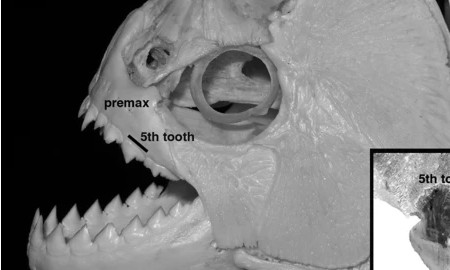
What did Megapiranha paranesis look like and what was its bite force
 Megapiranha paranensis is classified as a new genus of a giant, piranha-like species described from a single fossilized premaxilla jaw bone fragment that had a set of three triangular teeth set in a zig-zag pattern.
Megapiranha paranensis is classified as a new genus of a giant, piranha-like species described from a single fossilized premaxilla jaw bone fragment that had a set of three triangular teeth set in a zig-zag pattern.The Megapiranha paranensis is a lesser-known species of piranha that is closely related to the better-known Mega Piranha. It is a fascinating creature that has only recently been discovered, and its unique characteristics and behavior have captured the attention of scientists and the public alike. In this article, we will explore the history and characteristics of the Megapiranha paranensis, and some of the most interesting facts and data associated with this formidable fish.
History of the Megapiranha paranensis
The Megapiranha paranensis is a species of piranha that was first identified in 2012 by a team of researchers from the National Museum of Natural History in Paris, France. The team was studying the fossil record of piranhas when they came across a set of teeth that were unlike anything they had seen before. Upon further analysis, they realized that the teeth belonged to a previously unknown species of piranha, which they named Megapiranha paranensis.
The discovery of the Megapiranha paranensis was significant for several reasons. First, it provided new insight into the evolution of piranhas and their relationship to other fish species. Second, it shed light on the diversity of piranhas that existed in the past, and the potential for other undiscovered species to exist in modern times.
Characteristics of the Megapiranha paranensis
The Megapiranha paranensis is similar to the Mega Piranha in many ways, but there are several key differences that set it apart. For starters, the Megapiranha paranensis is slightly smaller than its cousin, typically growing to around two feet in length and weighing up to 12 pounds. Its body is also more streamlined, with a less muscular build and smaller fins that are better suited for swimming in open water.
What is the bite force of a megapiranha
One of the most interesting features of the Megapiranha paranensis is its teeth. Like other piranhas, it has sharp, pointed teeth that are designed for slicing through flesh and bone. However, its teeth are also much larger and more robust than those of other piranhas, which allows it to bite with incredible force. Researchers believe that the Megapiranha paranensis had a bite force that was three times greater than that of the modern-day Great White Shark, making it one of the most formidable predators to ever exist in freshwater environments.
Facts and Data about the Megapiranha paranensis
Diet: The Megapiranha paranensis was a carnivorous fish that fed on smaller fish and other aquatic animals. Its large teeth and powerful jaws allowed it to take down prey that was much larger than itself, making it a formidable predator in its environment.
Habitat: The Megapiranha paranensis is believed to have lived in the freshwater rivers and lakes of South America, particularly in the Amazon basin. It preferred warm, shallow water with plenty of vegetation and hiding places for prey.
Threats: The Megapiranha paranensis is no longer extant, and thus, it is not considered an endangered species. However, it is likely that habitat destruction and overfishing played a role in its extinction, as is the case with many other freshwater species around the world.
Scientific Name: The scientific name for the Megapiranha paranensis is Megapiranha paranensis. It belongs to the family Serrasalmidae, which includes other piranha species as well as pacus and silver dollars.
Evolution: The discovery of the Megapiranha paranensis shed new light on the evolution of piranhas and their relationship to other fish species. Researchers believe that piranhas evolved from herbivorous fish that lived in freshwater environments, and that their predatory behavior evolved in response to changes.